Falklands Island Photo Tour
January 17-February 2, 2020
Price: $9595
6 participants
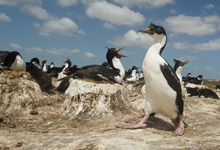
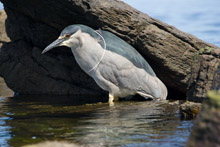
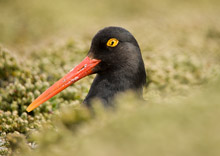
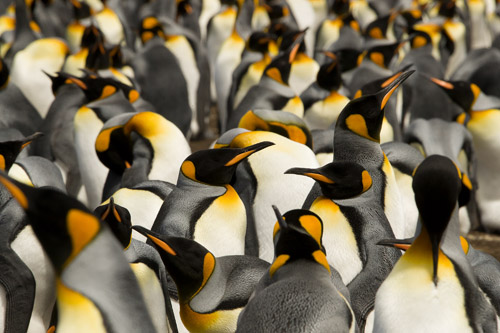
If you want to photograph sub-Antarctic wildlife, particularly Penguins, there is no better location than the Falkland Islands. We've been traveling to the Falklands since the 1990s, and nothing compares, in terms of time with the wildlife, guaranteed accessibility, and economy of travel.
Consider these points:
Penguin species - There are five species you are likely to photograph - King, Rockhopper, Gentoo, Magellanic, and Gentoo - South Georgia only has 4! The Antarctic peninsula has 3!
Land-based - We fly from island to island, so even in bad weather you're on land, and able to photograph. On boat-based trips, if there are high winds and stormy seas, you are out of luck - the zodiacs can't land.
Small groups and Plenty of Time - At most of our destinations our group is the only tourists. You'll have the freedom to stay with a subject as long as you wish, without the worry of a deadline to get back to a ship. Want to spend hours watching a penguin colony, or waiting for the shot? Want to shoot in pre-dawn light? You can!
A Diversity of Subjects - You're likely to photograph at least 30 different species of birds and mammals, including Elephant Seals, Southern Sealions, the 5 Penguins, Striated Caracaras, various geese, ducks, gulls, and seabirds, and songbirds. Contrast that with South Georgia or Antarctica -- the variety does not come close!
What You Won't See
The Falklands does not have the vast (hundreds of thousands) of King Penguins in single colonies. The largest colony in the Falklands numbers around 1,000 birds. Not evey visit to those South Georgia colonies are successful - if there's high winds and bad seas, you can't land. On the Falklands, you're not dependent upon the weather.
The Falklands do not have snow-capped mountains or glaciers -- you won't photograph the 'grand Antarctic landscape'
in the Falklands
You won't see scores of people in your shots. We're usually alone, and at most destinations you can walk where ever you wish to obtain the perspective you want.
This does not include being inside a nesting colony however!
Summing Up ...
The Falkland Islands are often called 'The Galapagos of the South Atlantic' for a reason. The wildlife - birds and mammals - are tame and easy to photograph. Further, unlike the rather tight restrictions for wildlife viewing in South Georgia and Antarctica, in the Falklands there is plenty of freedom for shooting. No one is looking over your shoulder, except Mary and I -- should we need to, but common sense, ethical behavior is all we ask for, as do the owners of the various islands.
The Falklands are simply fantastic. Join us, and read on!
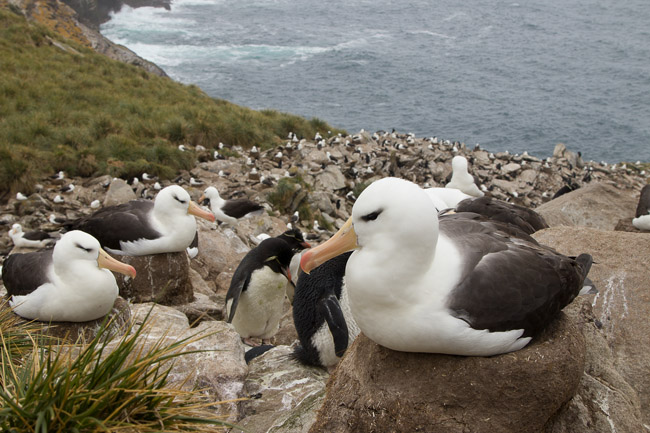
Our Itinerary for our January 18-February 1, 2020 tour:
January 18. Arrive in Falklands via LATAM flight from Chile. Overnight, Malvina Hotel.
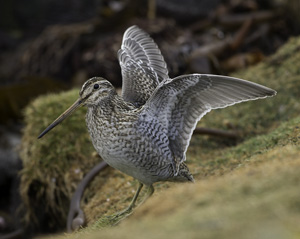 January 19-20. Flight to Carcass Island where we'll stay for the next two nights. We'll spend the majority of our time around the settlement, photographing the wealth of birds found in the gardens, grassy meadows, tidal pools, and the shallow bay. Kelp, Upland, and Ruddy-headed Geese, Pied and Black Oystercatchers, Black-crowned Night Herons, South American Terns, Common Snipe, Striated Caracaras, Kelp and Dolphin Gulls, Patagonian Crested and Flightless Steamer Ducks, Cobb's Wrens, Marsh Wren, Falkland Thrush, Turkey Vultures, and more! Overnight, Carcass Is. settlement
January 19-20. Flight to Carcass Island where we'll stay for the next two nights. We'll spend the majority of our time around the settlement, photographing the wealth of birds found in the gardens, grassy meadows, tidal pools, and the shallow bay. Kelp, Upland, and Ruddy-headed Geese, Pied and Black Oystercatchers, Black-crowned Night Herons, South American Terns, Common Snipe, Striated Caracaras, Kelp and Dolphin Gulls, Patagonian Crested and Flightless Steamer Ducks, Cobb's Wrens, Marsh Wren, Falkland Thrush, Turkey Vultures, and more! Overnight, Carcass Is. settlement
January 21-22. Flight to Saunders Island. Depending upon our arrival time we may do a late afternoon shoot to theRookery for Rockhopper Penguins and Black-browed Albatross. Overnight, the Settlement.
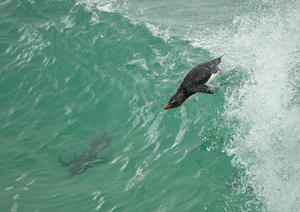 January 23-24. Transfer to the Neck for two days of incredible photography. Here there are multiple colonies of Gentoo Penguins, a small colony of King Penguins, numerous Magellanic Penguins, and one of the most exciting locations for photographing the avian soccer ball - the Rockhopper Penguin, that surfs in and climbs the steep rocks to reach their nesting colonies. Great Black-browed Albatross and King Cormorant Colonies, and Striated Caracaras patrolling the colonies seeking unattended penguin chicks. Incredible shooting! Overnight, the Neck Portacabin.. Subjects include huge Gentoo Penguin colonies; Rock-hopper Penguins - including surfing in to the cliffs; King Cormorants; Black-browed Albatrosses nesting; Striated Caracaras; both Oystercatchers; Skuas; Kelp and Dolphin Gulls; and more! Overnight, the Neck Portacabin.
January 23-24. Transfer to the Neck for two days of incredible photography. Here there are multiple colonies of Gentoo Penguins, a small colony of King Penguins, numerous Magellanic Penguins, and one of the most exciting locations for photographing the avian soccer ball - the Rockhopper Penguin, that surfs in and climbs the steep rocks to reach their nesting colonies. Great Black-browed Albatross and King Cormorant Colonies, and Striated Caracaras patrolling the colonies seeking unattended penguin chicks. Incredible shooting! Overnight, the Neck Portacabin.. Subjects include huge Gentoo Penguin colonies; Rock-hopper Penguins - including surfing in to the cliffs; King Cormorants; Black-browed Albatrosses nesting; Striated Caracaras; both Oystercatchers; Skuas; Kelp and Dolphin Gulls; and more! Overnight, the Neck Portacabin.
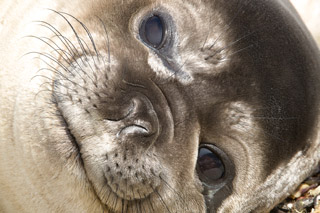
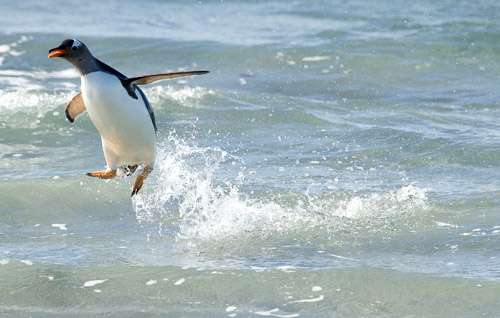
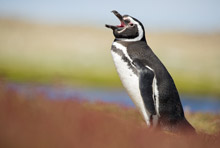
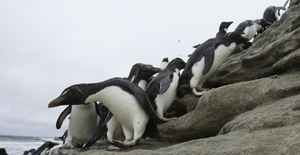 January 25-26. Transfer to Bleaker Island. Great Rockhopper and Gentoo Penguin colonies, local landscapes, Magellanic Penguins.
January 25-26. Transfer to Bleaker Island. Great Rockhopper and Gentoo Penguin colonies, local landscapes, Magellanic Penguins.
January 27-29. Flight to Sea Lion Island. Often called the Serengeti of the Falklands, virtually all the islands wildlife can be found here. Subjects include Southern Elephant Seals; Southern Sealions; huge Gentoo Penguin colonies; Magellanic Penguins; Kelp, Upland, and Ashy-headed Geese; Falkland Skuas; Falkland Snipe; Silver Grebes; Black and Pied Oystercatchers; Striated Caracaras; and more!
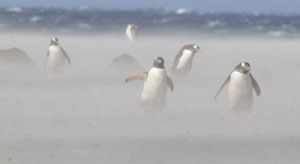
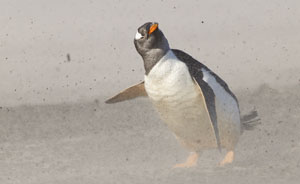
January 30 .Flight to Stanley. Free afternoon for bird photography along the shoreline. Possible excursion (not included) to another rookery near Stanley, where a few Northern Rock-hoppers are found. Overnight, the Malvinas Hotel.
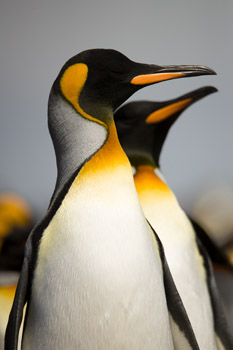 January 31.Day trip to Volunteer Point. Subjects include the largest King Penguin colony in the Falklands, as well as Gentoo and Magellanic Penguins, Upland Geese, Passerine (Songbirds), and more.
Overnight, Malvinas Hotel.
January 31.Day trip to Volunteer Point. Subjects include the largest King Penguin colony in the Falklands, as well as Gentoo and Magellanic Penguins, Upland Geese, Passerine (Songbirds), and more.
Overnight, Malvinas Hotel.
February 1. Late morning transfer to the airport. Mid-afternoon flight to Punta Arenas, Chile. Departure for home.
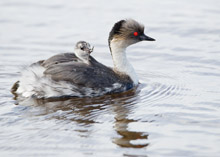
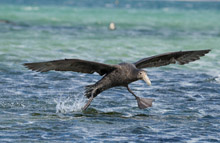
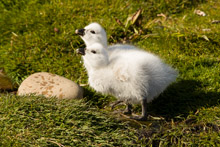
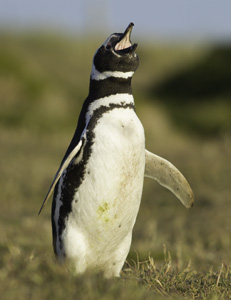
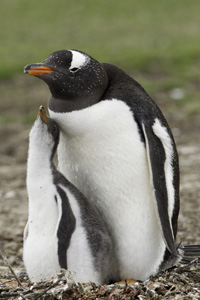
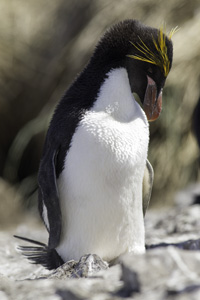
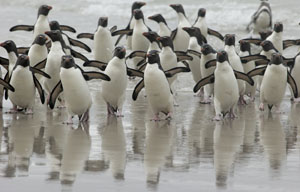
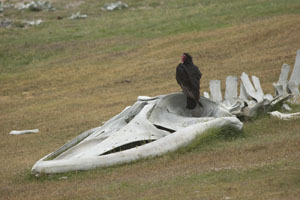
Falklands Island Photo Tour
January 17-February 2, 2020
Price: $9595
6 participants




If you want to photograph sub-Antarctic wildlife, particularly Penguins, there is no better location than the Falkland Islands. We've been traveling to the Falklands since the 1990s, and nothing compares, in terms of time with the wildlife, guaranteed accessibility, and economy of travel.
Consider these points:
Penguin species - There are five species you are likely to photograph - King, Rockhopper, Gentoo, Magellanic, and Gentoo - South Georgia only has 4! The Antarctic peninsula has 3!
Land-based - We fly from island to island, so even in bad weather you're on land, and able to photograph. On boat-based trips, if there are high winds and stormy seas, you are out of luck - the zodiacs can't land.
Small groups and Plenty of Time - At most of our destinations our group is the only tourists. You'll have the freedom to stay with a subject as long as you wish, without the worry of a deadline to get back to a ship. Want to spend hours watching a penguin colony, or waiting for the shot? Want to shoot in pre-dawn light? You can!
A Diversity of Subjects - You're likely to photograph at least 30 different species of birds and mammals, including Elephant Seals, Southern Sealions, the 5 Penguins, Striated Caracaras, various geese, ducks, gulls, and seabirds, and songbirds. Contrast that with South Georgia or Antarctica -- the variety does not come close!
What You Won't See
The Falklands does not have the vast (hundreds of thousands) of King Penguins in single colonies. The largest colony in the Falklands numbers around 1,000 birds. Not evey visit to those South Georgia colonies are successful - if there's high winds and bad seas, you can't land. On the Falklands, you're not dependent upon the weather.
The Falklands do not have snow-capped mountains or glaciers -- you won't photograph the 'grand Antarctic landscape'
in the Falklands
You won't see scores of people in your shots. We're usually alone, and at most destinations you can walk where ever you wish to obtain the perspective you want.
This does not include being inside a nesting colony however!
Summing Up ...
The Falkland Islands are often called 'The Galapagos of the South Atlantic' for a reason. The wildlife - birds and mammals - are tame and easy to photograph. Further, unlike the rather tight restrictions for wildlife viewing in South Georgia and Antarctica, in the Falklands there is plenty of freedom for shooting. No one is looking over your shoulder, except Mary and I -- should we need to, but common sense, ethical behavior is all we ask for, as do the owners of the various islands.
The Falklands are simply fantastic. Join us, and read on!

Our Itinerary for our January 18-February 1, 2020 tour:
January 18. Arrive in Falklands via LATAM flight from Chile. Overnight, Malvina Hotel.
 January 19-20. Flight to Carcass Island where we'll stay for the next two nights. We'll spend the majority of our time around the settlement, photographing the wealth of birds found in the gardens, grassy meadows, tidal pools, and the shallow bay. Kelp, Upland, and Ruddy-headed Geese, Pied and Black Oystercatchers, Black-crowned Night Herons, South American Terns, Common Snipe, Striated Caracaras, Kelp and Dolphin Gulls, Patagonian Crested and Flightless Steamer Ducks, Cobb's Wrens, Marsh Wren, Falkland Thrush, Turkey Vultures, and more! Overnight, Carcass Is. settlement
January 19-20. Flight to Carcass Island where we'll stay for the next two nights. We'll spend the majority of our time around the settlement, photographing the wealth of birds found in the gardens, grassy meadows, tidal pools, and the shallow bay. Kelp, Upland, and Ruddy-headed Geese, Pied and Black Oystercatchers, Black-crowned Night Herons, South American Terns, Common Snipe, Striated Caracaras, Kelp and Dolphin Gulls, Patagonian Crested and Flightless Steamer Ducks, Cobb's Wrens, Marsh Wren, Falkland Thrush, Turkey Vultures, and more! Overnight, Carcass Is. settlement
January 21-22. Flight to Saunders Island. Depending upon our arrival time we may do a late afternoon shoot to theRookery for Rockhopper Penguins and Black-browed Albatross. Overnight, the Settlement.
 January 23-24. Transfer to the Neck for two days of incredible photography. Here there are multiple colonies of Gentoo Penguins, a small colony of King Penguins, numerous Magellanic Penguins, and one of the most exciting locations for photographing the avian soccer ball - the Rockhopper Penguin, that surfs in and climbs the steep rocks to reach their nesting colonies. Great Black-browed Albatross and King Cormorant Colonies, and Striated Caracaras patrolling the colonies seeking unattended penguin chicks. Incredible shooting! Overnight, the Neck Portacabin.. Subjects include huge Gentoo Penguin colonies; Rock-hopper Penguins - including surfing in to the cliffs; King Cormorants; Black-browed Albatrosses nesting; Striated Caracaras; both Oystercatchers; Skuas; Kelp and Dolphin Gulls; and more! Overnight, the Neck Portacabin.
January 23-24. Transfer to the Neck for two days of incredible photography. Here there are multiple colonies of Gentoo Penguins, a small colony of King Penguins, numerous Magellanic Penguins, and one of the most exciting locations for photographing the avian soccer ball - the Rockhopper Penguin, that surfs in and climbs the steep rocks to reach their nesting colonies. Great Black-browed Albatross and King Cormorant Colonies, and Striated Caracaras patrolling the colonies seeking unattended penguin chicks. Incredible shooting! Overnight, the Neck Portacabin.. Subjects include huge Gentoo Penguin colonies; Rock-hopper Penguins - including surfing in to the cliffs; King Cormorants; Black-browed Albatrosses nesting; Striated Caracaras; both Oystercatchers; Skuas; Kelp and Dolphin Gulls; and more! Overnight, the Neck Portacabin.



 January 25-26. Transfer to Bleaker Island. Great Rockhopper and Gentoo Penguin colonies, local landscapes, Magellanic Penguins.
January 25-26. Transfer to Bleaker Island. Great Rockhopper and Gentoo Penguin colonies, local landscapes, Magellanic Penguins.
January 27-29. Flight to Sea Lion Island. Often called the Serengeti of the Falklands, virtually all the islands wildlife can be found here. Subjects include Southern Elephant Seals; Southern Sealions; huge Gentoo Penguin colonies; Magellanic Penguins; Kelp, Upland, and Ashy-headed Geese; Falkland Skuas; Falkland Snipe; Silver Grebes; Black and Pied Oystercatchers; Striated Caracaras; and more!


January 30 .Flight to Stanley. Free afternoon for bird photography along the shoreline. Possible excursion (not included) to another rookery near Stanley, where a few Northern Rock-hoppers are found. Overnight, the Malvinas Hotel.
 January 31.Day trip to Volunteer Point. Subjects include the largest King Penguin colony in the Falklands, as well as Gentoo and Magellanic Penguins, Upland Geese, Passerine (Songbirds), and more.
Overnight, Malvinas Hotel.
January 31.Day trip to Volunteer Point. Subjects include the largest King Penguin colony in the Falklands, as well as Gentoo and Magellanic Penguins, Upland Geese, Passerine (Songbirds), and more.
Overnight, Malvinas Hotel.
February 1. Late morning transfer to the airport. Mid-afternoon flight to Punta Arenas, Chile. Departure for home.








Falklands Island Photo Tour
January 17-February 2, 2020
Price: $9595
6 participants




If you want to photograph sub-Antarctic wildlife, particularly Penguins, there is no better location than the Falkland Islands. We've been traveling to the Falklands since the 1990s, and nothing compares, in terms of time with the wildlife, guaranteed accessibility, and economy of travel.
Consider these points:
Penguin species - There are five species you are likely to photograph - King, Rockhopper, Gentoo, Magellanic, and Gentoo - South Georgia only has 4! The Antarctic peninsula has 3!
Land-based - We fly from island to island, so even in bad weather you're on land, and able to photograph. On boat-based trips, if there are high winds and stormy seas, you are out of luck - the zodiacs can't land.
Small groups and Plenty of Time - At most of our destinations our group is the only tourists. You'll have the freedom to stay with a subject as long as you wish, without the worry of a deadline to get back to a ship. Want to spend hours watching a penguin colony, or waiting for the shot? Want to shoot in pre-dawn light? You can!
A Diversity of Subjects - You're likely to photograph at least 30 different species of birds and mammals, including Elephant Seals, Southern Sealions, the 5 Penguins, Striated Caracaras, various geese, ducks, gulls, and seabirds, and songbirds. Contrast that with South Georgia or Antarctica -- the variety does not come close!
What You Won't See
The Falklands does not have the vast (hundreds of thousands) of King Penguins in single colonies. The largest colony in the Falklands numbers around 1,000 birds. Not evey visit to those South Georgia colonies are successful - if there's high winds and bad seas, you can't land. On the Falklands, you're not dependent upon the weather.
The Falklands do not have snow-capped mountains or glaciers -- you won't photograph the 'grand Antarctic landscape'
in the Falklands
You won't see scores of people in your shots. We're usually alone, and at most destinations you can walk where ever you wish to obtain the perspective you want.
This does not include being inside a nesting colony however!
Summing Up ...
The Falkland Islands are often called 'The Galapagos of the South Atlantic' for a reason. The wildlife - birds and mammals - are tame and easy to photograph. Further, unlike the rather tight restrictions for wildlife viewing in South Georgia and Antarctica, in the Falklands there is plenty of freedom for shooting. No one is looking over your shoulder, except Mary and I -- should we need to, but common sense, ethical behavior is all we ask for, as do the owners of the various islands.
The Falklands are simply fantastic. Join us, and read on!

Our Itinerary for our January 18-February 1, 2020 tour:
January 18. Arrive in Falklands via LATAM flight from Chile. Overnight, Malvina Hotel.
 January 19-20. Flight to Carcass Island where we'll stay for the next two nights. We'll spend the majority of our time around the settlement, photographing the wealth of birds found in the gardens, grassy meadows, tidal pools, and the shallow bay. Kelp, Upland, and Ruddy-headed Geese, Pied and Black Oystercatchers, Black-crowned Night Herons, South American Terns, Common Snipe, Striated Caracaras, Kelp and Dolphin Gulls, Patagonian Crested and Flightless Steamer Ducks, Cobb's Wrens, Marsh Wren, Falkland Thrush, Turkey Vultures, and more! Overnight, Carcass Is. settlement
January 19-20. Flight to Carcass Island where we'll stay for the next two nights. We'll spend the majority of our time around the settlement, photographing the wealth of birds found in the gardens, grassy meadows, tidal pools, and the shallow bay. Kelp, Upland, and Ruddy-headed Geese, Pied and Black Oystercatchers, Black-crowned Night Herons, South American Terns, Common Snipe, Striated Caracaras, Kelp and Dolphin Gulls, Patagonian Crested and Flightless Steamer Ducks, Cobb's Wrens, Marsh Wren, Falkland Thrush, Turkey Vultures, and more! Overnight, Carcass Is. settlement
January 21-22. Flight to Saunders Island. Depending upon our arrival time we may do a late afternoon shoot to theRookery for Rockhopper Penguins and Black-browed Albatross. Overnight, the Settlement.
 January 23-24. Transfer to the Neck for two days of incredible photography. Here there are multiple colonies of Gentoo Penguins, a small colony of King Penguins, numerous Magellanic Penguins, and one of the most exciting locations for photographing the avian soccer ball - the Rockhopper Penguin, that surfs in and climbs the steep rocks to reach their nesting colonies. Great Black-browed Albatross and King Cormorant Colonies, and Striated Caracaras patrolling the colonies seeking unattended penguin chicks. Incredible shooting! Overnight, the Neck Portacabin.. Subjects include huge Gentoo Penguin colonies; Rock-hopper Penguins - including surfing in to the cliffs; King Cormorants; Black-browed Albatrosses nesting; Striated Caracaras; both Oystercatchers; Skuas; Kelp and Dolphin Gulls; and more! Overnight, the Neck Portacabin.
January 23-24. Transfer to the Neck for two days of incredible photography. Here there are multiple colonies of Gentoo Penguins, a small colony of King Penguins, numerous Magellanic Penguins, and one of the most exciting locations for photographing the avian soccer ball - the Rockhopper Penguin, that surfs in and climbs the steep rocks to reach their nesting colonies. Great Black-browed Albatross and King Cormorant Colonies, and Striated Caracaras patrolling the colonies seeking unattended penguin chicks. Incredible shooting! Overnight, the Neck Portacabin.. Subjects include huge Gentoo Penguin colonies; Rock-hopper Penguins - including surfing in to the cliffs; King Cormorants; Black-browed Albatrosses nesting; Striated Caracaras; both Oystercatchers; Skuas; Kelp and Dolphin Gulls; and more! Overnight, the Neck Portacabin.



 January 25-26. Transfer to Bleaker Island. Great Rockhopper and Gentoo Penguin colonies, local landscapes, Magellanic Penguins.
January 25-26. Transfer to Bleaker Island. Great Rockhopper and Gentoo Penguin colonies, local landscapes, Magellanic Penguins.
January 27-29. Flight to Sea Lion Island. Often called the Serengeti of the Falklands, virtually all the islands wildlife can be found here. Subjects include Southern Elephant Seals; Southern Sealions; huge Gentoo Penguin colonies; Magellanic Penguins; Kelp, Upland, and Ashy-headed Geese; Falkland Skuas; Falkland Snipe; Silver Grebes; Black and Pied Oystercatchers; Striated Caracaras; and more!


January 30 .Flight to Stanley. Free afternoon for bird photography along the shoreline. Possible excursion (not included) to another rookery near Stanley, where a few Northern Rock-hoppers are found. Overnight, the Malvinas Hotel.
 January 31.Day trip to Volunteer Point. Subjects include the largest King Penguin colony in the Falklands, as well as Gentoo and Magellanic Penguins, Upland Geese, Passerine (Songbirds), and more.
Overnight, Malvinas Hotel.
January 31.Day trip to Volunteer Point. Subjects include the largest King Penguin colony in the Falklands, as well as Gentoo and Magellanic Penguins, Upland Geese, Passerine (Songbirds), and more.
Overnight, Malvinas Hotel.
February 1. Late morning transfer to the airport. Mid-afternoon flight to Punta Arenas, Chile. Departure for home.








Falklands Island Photo Tour
January 17-February 2, 2020
Price: $9595
6 participants




If you want to photograph sub-Antarctic wildlife, particularly Penguins, there is no better location than the Falkland Islands. We've been traveling to the Falklands since the 1990s, and nothing compares, in terms of time with the wildlife, guaranteed accessibility, and economy of travel.
Consider these points:
Penguin species - There are five species you are likely to photograph - King, Rockhopper, Gentoo, Magellanic, and Gentoo - South Georgia only has 4! The Antarctic peninsula has 3!
Land-based - We fly from island to island, so even in bad weather you're on land, and able to photograph. On boat-based trips, if there are high winds and stormy seas, you are out of luck - the zodiacs can't land.
Small groups and Plenty of Time - At most of our destinations our group is the only tourists. You'll have the freedom to stay with a subject as long as you wish, without the worry of a deadline to get back to a ship. Want to spend hours watching a penguin colony, or waiting for the shot? Want to shoot in pre-dawn light? You can!
A Diversity of Subjects - You're likely to photograph at least 30 different species of birds and mammals, including Elephant Seals, Southern Sealions, the 5 Penguins, Striated Caracaras, various geese, ducks, gulls, and seabirds, and songbirds. Contrast that with South Georgia or Antarctica -- the variety does not come close!
What You Won't See
The Falklands does not have the vast (hundreds of thousands) of King Penguins in single colonies. The largest colony in the Falklands numbers around 1,000 birds. Not evey visit to those South Georgia colonies are successful - if there's high winds and bad seas, you can't land. On the Falklands, you're not dependent upon the weather.
The Falklands do not have snow-capped mountains or glaciers -- you won't photograph the 'grand Antarctic landscape'
in the Falklands
You won't see scores of people in your shots. We're usually alone, and at most destinations you can walk where ever you wish to obtain the perspective you want.
This does not include being inside a nesting colony however!
Summing Up ...
The Falkland Islands are often called 'The Galapagos of the South Atlantic' for a reason. The wildlife - birds and mammals - are tame and easy to photograph. Further, unlike the rather tight restrictions for wildlife viewing in South Georgia and Antarctica, in the Falklands there is plenty of freedom for shooting. No one is looking over your shoulder, except Mary and I -- should we need to, but common sense, ethical behavior is all we ask for, as do the owners of the various islands.
The Falklands are simply fantastic. Join us, and read on!

Our Itinerary for our January 18-February 1, 2020 tour:
January 18. Arrive in Falklands via LATAM flight from Chile. Overnight, Malvina Hotel.
 January 19-20. Flight to Carcass Island where we'll stay for the next two nights. We'll spend the majority of our time around the settlement, photographing the wealth of birds found in the gardens, grassy meadows, tidal pools, and the shallow bay. Kelp, Upland, and Ruddy-headed Geese, Pied and Black Oystercatchers, Black-crowned Night Herons, South American Terns, Common Snipe, Striated Caracaras, Kelp and Dolphin Gulls, Patagonian Crested and Flightless Steamer Ducks, Cobb's Wrens, Marsh Wren, Falkland Thrush, Turkey Vultures, and more! Overnight, Carcass Is. settlement
January 19-20. Flight to Carcass Island where we'll stay for the next two nights. We'll spend the majority of our time around the settlement, photographing the wealth of birds found in the gardens, grassy meadows, tidal pools, and the shallow bay. Kelp, Upland, and Ruddy-headed Geese, Pied and Black Oystercatchers, Black-crowned Night Herons, South American Terns, Common Snipe, Striated Caracaras, Kelp and Dolphin Gulls, Patagonian Crested and Flightless Steamer Ducks, Cobb's Wrens, Marsh Wren, Falkland Thrush, Turkey Vultures, and more! Overnight, Carcass Is. settlement
January 21-22. Flight to Saunders Island. Depending upon our arrival time we may do a late afternoon shoot to theRookery for Rockhopper Penguins and Black-browed Albatross. Overnight, the Settlement.
 January 23-24. Transfer to the Neck for two days of incredible photography. Here there are multiple colonies of Gentoo Penguins, a small colony of King Penguins, numerous Magellanic Penguins, and one of the most exciting locations for photographing the avian soccer ball - the Rockhopper Penguin, that surfs in and climbs the steep rocks to reach their nesting colonies. Great Black-browed Albatross and King Cormorant Colonies, and Striated Caracaras patrolling the colonies seeking unattended penguin chicks. Incredible shooting! Overnight, the Neck Portacabin.. Subjects include huge Gentoo Penguin colonies; Rock-hopper Penguins - including surfing in to the cliffs; King Cormorants; Black-browed Albatrosses nesting; Striated Caracaras; both Oystercatchers; Skuas; Kelp and Dolphin Gulls; and more! Overnight, the Neck Portacabin.
January 23-24. Transfer to the Neck for two days of incredible photography. Here there are multiple colonies of Gentoo Penguins, a small colony of King Penguins, numerous Magellanic Penguins, and one of the most exciting locations for photographing the avian soccer ball - the Rockhopper Penguin, that surfs in and climbs the steep rocks to reach their nesting colonies. Great Black-browed Albatross and King Cormorant Colonies, and Striated Caracaras patrolling the colonies seeking unattended penguin chicks. Incredible shooting! Overnight, the Neck Portacabin.. Subjects include huge Gentoo Penguin colonies; Rock-hopper Penguins - including surfing in to the cliffs; King Cormorants; Black-browed Albatrosses nesting; Striated Caracaras; both Oystercatchers; Skuas; Kelp and Dolphin Gulls; and more! Overnight, the Neck Portacabin.



 January 25-26. Transfer to Bleaker Island. Great Rockhopper and Gentoo Penguin colonies, local landscapes, Magellanic Penguins.
January 25-26. Transfer to Bleaker Island. Great Rockhopper and Gentoo Penguin colonies, local landscapes, Magellanic Penguins.
January 27-29. Flight to Sea Lion Island. Often called the Serengeti of the Falklands, virtually all the islands wildlife can be found here. Subjects include Southern Elephant Seals; Southern Sealions; huge Gentoo Penguin colonies; Magellanic Penguins; Kelp, Upland, and Ashy-headed Geese; Falkland Skuas; Falkland Snipe; Silver Grebes; Black and Pied Oystercatchers; Striated Caracaras; and more!


January 30 .Flight to Stanley. Free afternoon for bird photography along the shoreline. Possible excursion (not included) to another rookery near Stanley, where a few Northern Rock-hoppers are found. Overnight, the Malvinas Hotel.
 January 31.Day trip to Volunteer Point. Subjects include the largest King Penguin colony in the Falklands, as well as Gentoo and Magellanic Penguins, Upland Geese, Passerine (Songbirds), and more.
Overnight, Malvinas Hotel.
January 31.Day trip to Volunteer Point. Subjects include the largest King Penguin colony in the Falklands, as well as Gentoo and Magellanic Penguins, Upland Geese, Passerine (Songbirds), and more.
Overnight, Malvinas Hotel.
February 1. Late morning transfer to the airport. Mid-afternoon flight to Punta Arenas, Chile. Departure for home.








Please contact our office
About Your Leaders
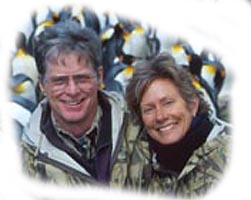 My wife Mary Ann and I strive to provide the most comfortable and
My wife Mary Ann and I strive to provide the most comfortable and
thorough safari you will experience. Both Mary and I are professional photographers, and I'd hope you've seen our credits. These included
National Geographic, National Wildlife, Ranger Rick, Natural History,
Living Bird, Birder's World, and most nature/wildlife calendars.
As a husband/wife team, Mary Ann and I have won more times in the
prestigious BBC Wildlife Photographer of the Year competition than any
one. To date we have had 15 firsts, seconds, or thirds -- and we have
not entered every year. Our trips are not about us, however, they are all
for you, but credentials seem to matter, and we have them.
Mary has written twenty-nine (29) children's books, including Leopards, Grizzly Bears, Woodpeckers,
Flying Squirrels, Sunflowers, Cobras, Jupiter, Boas, Garter Snakes, Pythons, Rattlesnakes, Ducks, Chickens, Horses, and Cows, and a coffee table book, Out of the Past, Amish Tradition and Faith.
I've written several how-to wildlife photography books -- A Practical Guide to Photographing American Wildlife,
The Wildlife Photographer's Field Manual, The Complete Guide to Wildlife Photography, Designing Wildlife
Photographs, Photographing on Safari, A Field Guide to Photographing in East Africa, and the New Complete
Guide to Wildlife Photography, African Wildlife, Creatures of the Night, The World's Deadliest, and several
ebooks. We have produced an instructional video, A Video Guide to Photographing on Safari with
Joe and Mary Ann McDonald.
We are both editors for Nature Photographer magazine.
In addition to leading our trips to Tanzania, Mary and I personally lead photo safaris to Kenya,
Brazil's Pantanal, Chile, Galapagos, Svalbard, India, Alaska, Rwanda, Yellowstone, Ecuador, Costa Rica,
the Falklands, Antarctica, South Texas, Arizona, and some other spots, too!
Please contact our office
About Your Leaders
 My wife Mary Ann and I strive to provide the most comfortable and
My wife Mary Ann and I strive to provide the most comfortable and
thorough safari you will experience. Both Mary and I are professional photographers, and I'd hope you've seen our credits. These included
National Geographic, National Wildlife, Ranger Rick, Natural History,
Living Bird, Birder's World, and most nature/wildlife calendars.
As a husband/wife team, Mary Ann and I have won more times in the
prestigious BBC Wildlife Photographer of the Year competition than any
one. To date we have had 15 firsts, seconds, or thirds -- and we have
not entered every year. Our trips are not about us, however, they are all
for you, but credentials seem to matter, and we have them.
Mary has written twenty-nine (29) children's books, including Leopards, Grizzly Bears, Woodpeckers,
Flying Squirrels, Sunflowers, Cobras, Jupiter, Boas, Garter Snakes, Pythons, Rattlesnakes, Ducks, Chickens, Horses, and Cows, and a coffee table book, Out of the Past, Amish Tradition and Faith.
I've written several how-to wildlife photography books -- A Practical Guide to Photographing American Wildlife,
The Wildlife Photographer's Field Manual, The Complete Guide to Wildlife Photography, Designing Wildlife
Photographs, Photographing on Safari, A Field Guide to Photographing in East Africa, and the New Complete
Guide to Wildlife Photography, African Wildlife, Creatures of the Night, The World's Deadliest, and several
ebooks. We have produced an instructional video, A Video Guide to Photographing on Safari with
Joe and Mary Ann McDonald.
We are both editors for Nature Photographer magazine.
In addition to leading our trips to Tanzania, Mary and I personally lead photo safaris to Kenya,
Brazil's Pantanal, Chile, Galapagos, Svalbard, India, Alaska, Rwanda, Yellowstone, Ecuador, Costa Rica,
the Falklands, Antarctica, South Texas, Arizona, and some other spots, too!
Please contact our office
About Your LeadersPlease contact our office
 My wife Mary Ann and I strive to provide the most comfortable and
My wife Mary Ann and I strive to provide the most comfortable and thorough safari you will experience. Both Mary and I are professional photographers, and I'd hope you've seen our credits. These included
National Geographic, National Wildlife, Ranger Rick, Natural History,
Living Bird, Birder's World, and most nature/wildlife calendars.
As a husband/wife team, Mary Ann and I have won more times in the
prestigious BBC Wildlife Photographer of the Year competition than any
one. To date we have had 15 firsts, seconds, or thirds -- and we have
not entered every year. Our trips are not about us, however, they are all
for you, but credentials seem to matter, and we have them.
Mary has written twenty-nine (29) children's books, including Leopards, Grizzly Bears, Woodpeckers,
Flying Squirrels, Sunflowers, Cobras, Jupiter, Boas, Garter Snakes, Pythons, Rattlesnakes, Ducks, Chickens, Horses, and Cows, and a coffee table book, Out of the Past, Amish Tradition and Faith.
I've written several how-to wildlife photography books -- A Practical Guide to Photographing American Wildlife,
The Wildlife Photographer's Field Manual, The Complete Guide to Wildlife Photography, Designing Wildlife
Photographs, Photographing on Safari, A Field Guide to Photographing in East Africa, and the New Complete
Guide to Wildlife Photography, African Wildlife, Creatures of the Night, The World's Deadliest, and several
ebooks. We have produced an instructional video, A Video Guide to Photographing on Safari with
Joe and Mary Ann McDonald.
We are both editors for Nature Photographer magazine.
In addition to leading our trips to Tanzania, Mary and I personally lead photo safaris to Kenya,
Brazil's Pantanal, Chile, Galapagos, Svalbard, India, Alaska, Rwanda, Yellowstone, Ecuador, Costa Rica,
the Falklands, Antarctica, South Texas, Arizona, and some other spots, too!


